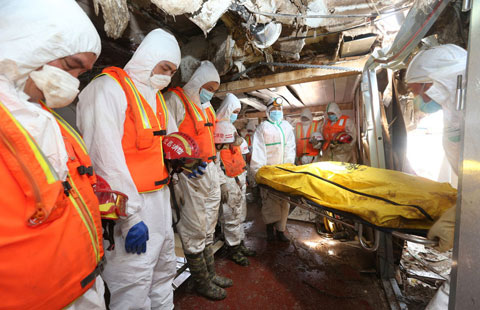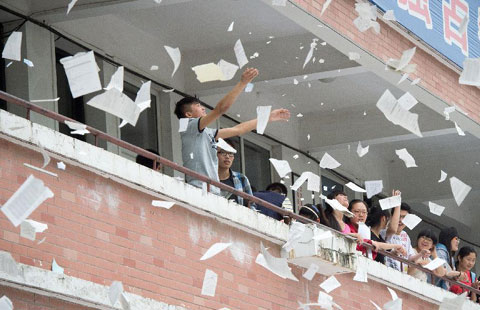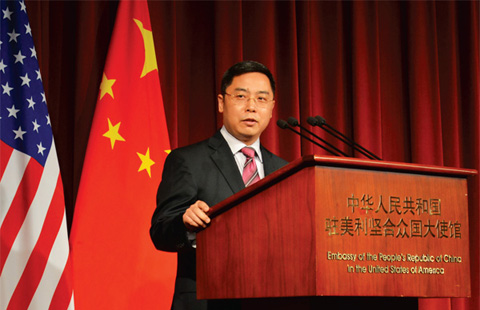Startups return to China to battle pollution
Updated: 2015-06-06 01:09
(China Daily USA)
|
||||||||
 |
|
Chinese entrepreneurs from the Silicon Valley are using their US-gained knowledge and expertise to battle against China's worsening environmental problems. FOR CHINA DAILY USA |
Some Chinese entrepreneurs in Silicon Valley are returning to their home country to launch startups focusing on one of China's biggest problems — air pollution, especially smog, Lia Zhu reports from San Francisco.
When a major sand storm hit Beijing 15 years ago, Carl Wang was shocked to see the sky turn orange while sitting in his high school classroom. The bad air quality caused by the storm would play a major role in putting him on a path to become an environmental engineer. Now, pollution in his hometown of Beijing has worsened and will help determine his path back in China.
More than 10 years after that incident, Wang got his doctorate in the United States, and is an expert on air quality monitoring/modeling and air pollution control at Environmental Resources Management, a consulting firm in the San Francisco Bay Area.
Wang and the six other members of his team, all experts in computers, the environment or finance in California's Silicon Valley, expect to return to China in the second half of this year to launch their environmental startup: GAGO Inc. "Now is the most favorable time to launch our startup. We can't miss it," Wang told China Daily.
Next month, the software they developed, called "GAGO Smog Map", which provides real-time updates of smog levels and three to five days of forecasts, will be available to customers in China. "With this software, users will be able to check the smog level of any place in China with their smartphones," Wang said. "So they can make better decisions for travel."
Wang will be joining other Chinese who have returned to China from the United States to launch a startup. There are no definitive numbers on how many startups created by Chinese in the US have done so, but Wang, Kai Sun and Charlotte Wang (no relation to Carl Wang) are three entrepreneurs focusing on one of China's most pressing problems: air pollution, especially smog.
Tackling health-harming smog has become a major initiative of the central government. In January 2014, China, for the first time, included health-threatening smog in its 2013 natural disaster report.
In response to large-scale smog covering the robust Yangtze River Delta, Pearl River Delta and especially the Beijing-Tianjin-Hebei cluster in North China, the central government adopted the Air Pollution Prevention and Control Action Plan in September 2013. It is believed to be the strictest pollution control measure as the government vows to bring "visible changes" to air quality by the end of 2017.
Stations have been built in 161 cities to monitor smog levels to raise the public's self-protection awareness and enhance the government's sense of responsibility, Chinese Premier Li Keqiang told reporters at the conclusion of this year's National People's Congress.
"We certainly feel the pressure," said an atmospheric expert with a Shanghai environmental monitoring agency who requested anonymity. "We have never received so much attention until smog became a key word in 2013."
And more than ever, the Chinese public is focusing on smog. In March a privately sponsored documentary on smog, Under the Dome, went viral online in China. It was viewed more than 300 million times within five days.
"Of the 9.6-million-square-kilometers of China's territory, 5 million are covered with smog," Wang said. "I have families and friends there. I feel sad for them. I would not forgive myself if I didn't do something now."
It is not just smog
But it's not just smog. According to a 2013 environmental report by the Asia Development Bank, seven of the world's 10 most-polluted cities were in China and among the 500 largest Chinese cities, only five were considered at a safe level based on World Health Organization air quality guidelines.
Sun, founder and chief scientist of He-Sai Photonics Technologies, and his two partners took their startup from Silicon Valley to Shanghai last October. They design and manufacture online gas analyzers that can monitor mixed gas composition at a higher speed and with more precision than existing technologies.
"The technical gap between China and the US is diminishing. The sooner we come back, the earlier we can bring our technology into play," he said. "We expect to deliver the first products to our clients next month and begin manufacturing in the second half of this year."
Energy conservation is as important as finding the source of pollution. Last October, Charlotte Wang's startup – Equota Energy – returned to China and launched in Shanghai. The company's technology aims to help heavy industries, like steel plants, to optimize power consumption to reduce carbon emissions. By collecting data from smart meters, they can provide analysis and assessments based on algorithms that they have developed.
"This technology is available in the US but not in China yet. What we are doing now is localizing the software for our customers," she said. Their customers include industrial parks, and factories and commercial buildings like department stores and hotels.
One customer, a steel plant in East China, has saved $1 million on energy-related costs and realized a reduction equal to 5,000 tons of coal within six months.
Carl Wang and his team developed their software last year based on satellite remote sensing data. Through analysis of the big data, they can calculate the density of PM2.5, a major contributor to the smog in Beijing, and then convert the smog levels into a map.
PM2.5, or particulate matter with a diameter of 2.5 microns or less, is small enough to penetrate deep into the lungs and blood streams unfiltered and cause respiratory and cardiovascular diseases. It is also often associated with toxic substances like heavy metals or polycyclic aromatic hydrocarbons.
Wang said his team has been in talks with a few government agencies at provincial or city levels to build an air-quality monitoring data platform. "A visualized map is the first step. We plan to develop more practical products, like travel guidelines for urban residents, visualization tools for environmental professionals, or data analysis for enterprises or government agencies," Wang said.
Sun's products include gas analyzers and PM2.5 sensors, which can be used in such areas as atmospheric environmental monitoring, industrial process control and monitoring, as well as the detection of hazardous gas leakage. The equipment can be installed in buses or taxis, and when the vehicle is running the gas analyzer measures the data of the local air and uploads it to a network terminal so environmental agencies can determine the source of the pollution, he said.
The products' core technologies, including laser scattering and absorption spectroscopy, originated from the high temperature gas dynamics laboratory at Stanford University where Sun received his PhD in mechanical engineering and worked as a research associate before he returned to China.
"Our gas analyzers can monitor emissions at factory plume sites to ensure their emissions are within regulations. They can also measure the concentration of PM 2.5 suspended particulate in the air at local levels," Sun said. "Building a monitoring station usually costs millions of yuan and it is effective only within a certain area. Our portable equipment costs only one-tenth of the similar product and it does not need maintenance, either."
- Rescuers enter Eastern Star hull in search efforts
- China mourns Yangtze shipwreck victims as search continues
- 9.42 million students sit national college entrance exam
- Students prepare to take national college entrance exams
- TV giants suspend shows for ship wreck mourning
- China, Japan reopen finance talks after delay over sour relations
- Turks vote in election set to shape Erdogan's legacy
- Protesters block road to G7 summit site
- India, Bangladesh sign historic land boundary agreement
- Putin says no need for West to fear Russia
- MERS cases rise to 50 in S.Korea with 9 more infections
- Eleven hikers killed in Malaysia quake, eight still missing

 Rescuers mourn victims on seventh day since Eastern Star disaster
Rescuers mourn victims on seventh day since Eastern Star disaster
 Rescuers enter Eastern Star hull in search efforts
Rescuers enter Eastern Star hull in search efforts
 Gaokao held across China
Gaokao held across China
 Man sues actress for staring at him
Man sues actress for staring at him
 Students prepare to take national college entrance exams
Students prepare to take national college entrance exams
 Across America (May 29- June 4)
Across America (May 29- June 4)
 Operation underway to turn the ship over
Operation underway to turn the ship over
 Prayers held for ship passengers
Prayers held for ship passengers
Most Viewed
Editor's Picks

|

|

|

|

|

|
Today's Top News
Heavyweight Zhang wins unanimous decision
China mourns Yangtze shipwreck victims as search continues
China signs $50m agreement with FAO to support developing countries
9.42 million students sit national college entrance exam
Death toll jumps to 396
as hopes of finding any
survivor in cruise fade
China, Japan reopen finance talks after delay over sour relations
Hacking claim isn't responsible, Beijing says
Startups return to China to battle pollution
US Weekly

|

|







